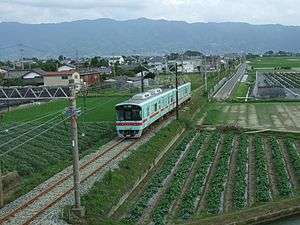Nishitetsu Amagi Line
The Nishitetsu Amagi Line (西鉄甘木線, Nishitetsu Amagi-sen) is a Japanese railway line operated by the private railway operator Nishi-Nippon Railroad (Nishitetsu), which connects Kurume and Asakura in Fukuoka Prefecture.[1]
| Nishitetsu Amagi Line | |
|---|---|
 Nishitetsu Amagi Line 7050 series EMU between Kaneshima and Ōzeki Station, July 2009 | |
| Overview | |
| Native name | 西鉄甘木線 |
| Type | Heavy rail |
| Locale | Fukuoka Prefecture |
| Termini | Miyanojin Station Amagi Station |
| Stations | 12 |
| Operation | |
| Owner | Nishi-Nippon Railroad |
| Technical | |
| Line length | 17.9 km |
| Number of tracks | Single |
| Track gauge | 1,435 mm (4 ft 8 1⁄2 in) |
| Minimum radius | 130 m |
| Electrification | 1,500 V DC |
| Operating speed | 65 km/h |
Stations
| Station name | Japanese | km | Transfers | Location | |
|---|---|---|---|---|---|
| T 25 Miyanojin | 宮の陣 | 0.0 | Nishitetsu Tenjin Ōmuta Line | Kurume | Fukuoka Prefecture |
| A 11 Gorōmaru | 五郎丸 | 0.9 | |||
| A 10 Gakkōmae | 学校前 | 1.7 | |||
| A 09 Koganchaya | 古賀茶屋 | 3.9 | |||
| A 08 Kitano | 北野 | 5.4 | |||
| A 07 Ōki | 大城 | 8.0 | |||
| A 06 Kaneshima | 金島 | 9.4 | |||
| A 05 Ōzeki | 大堰 | 11.6 | Tachiarai, Mii District | ||
| A 04 Hongō | 本郷 | 13.1 | |||
| A 03 Kamiura | 上浦 | 14.9 | Asakura | ||
| A 02 Mada | 馬田 | 16.1 | |||
| A 01 Amagi | 甘木 | 17.9 | Amagi Railway Amagi Line | ||
History
The Mitsui Electric Tramway (三井電気軌道, Mitsui Denki Kidō) opened a 1,435 mm (4 ft 8 1⁄2 in) gauge line electrified at 600 V DC from Miyanojin to Kitano in 1915. The Kitano to Amagi section opened in 1921.
On 30 June 1924, the Mitsui Electric tramway was absorbed into the Kyushu Railway system, this line becoming the Mitsui Line. In 1942, the Kyushu Railway merged with the Kyushu Electric Railway, becoming the Nishi-Nippon (translates as West Japan) Railway.
In 1948, the line voltage was increased to 1,500 V DC, the same year through-running commenced with the Tenjin Ōmuta Line and the line was renamed the Amagi Line.
From 1 October 1989, wanman driver only operation commenced on the line.[1]
References
This article incorporates material from the corresponding article in the Japanese Wikipedia.
- Terada, Hirokazu (July 2002). データブック日本の私鉄 (Databook: Japan's Private Railways). Japan: Neko Publishing. ISBN 4-87366-874-3.